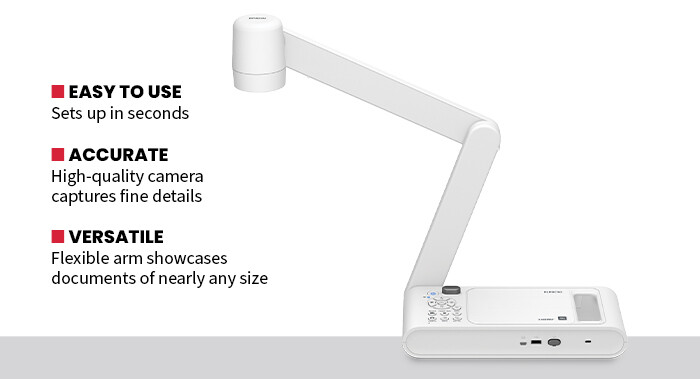In the modern classroom, document cameras resemble icebergs. At first glance, they may appear as simple devices for projecting books and papers, much like the traditional opaque projectors of the past. However, beneath the surface, a wealth of advanced features lies hidden.
Today’s document cameras can focus on virtually any object, capturing intricate details to share with students. They even have the capability to record video and document classroom lessons for future reference.
While traditional document cameras and their opaque predecessors serve essential functions, they have often been challenging to set up and operate. As an educator, I find document cameras invaluable, yet I often struggle with positioning them correctly, especially when I need to zoom in on specific sections of a text or image.
Moreover, older models tend to be cumbersome, heavy, and limited in functionality, typically offering just a manual zoom. Fortunately, the Epson DC-30 document camera is engineered to overcome these limitations, making it an ideal choice for today’s higher education settings.
Click below to discover how to modernize your learning environments.
Adaptability of the Epson DC-30 for Dynamic Learning Environments
After spending several weeks testing the DC-30 with various media, I was thoroughly impressed. Contrary to traditional bulky projectors, it is lightweight at just 6.11 pounds and features an articulated arm with a powerful HD camera that can pivot in any direction.
As my lectures evolved, whether prompted by student questions or the need to shift focus, repositioning the camera was a breeze. I could seamlessly zoom in on different aspects of documents that required emphasis.
RELATED: Modern projectors are paving the way for immersive educational experiences.
With an impressive resolution, the camera captures images or videos up to 4K quality, equipped with a 13-megapixel sensor, offering both 10x optical zoom and 23x digital zoom. I even zoomed in on a painting to observe individual brush strokes—something impossible with older classroom projectors.

Unmatched Video Capabilities of the Epson DC-30
While the primary use of the DC-30 may be to spotlight static objects like books or documents, it excels as a video camera as well. With a built-in microphone, the device can effortlessly record lectures, saving them to a USB flash drive for easy access. It’s also capable of capturing still images, which can be saved as JPEGs on the same drive. To save time, instructors can capture multiple images prior to class.
DISCOVER: What’s next for display technology in higher education?
The Epson DC-30 is an exceptional addition to any classroom, especially where sharing materials can significantly enhance learning experiences. It’s remarkably user-friendly and fosters greater student engagement.
Specifications
MAXIMUM DIGITAL CAPTURE RESOLUTION: 4208×3120 (4K) with 23x digital zoom
VIDEO RECORDING MODES: 1080p or 720p at 60 fps
PORTS: HDMI input and output, USB Type A, Mini USB Type B
STORAGE: USB Flash Drive
DIMENSIONS: 6.3×23.1×21.8 inches
WEIGHT: 6.11 pounds
KEEP READING: Effective strategies to optimize existing classroom technology.





